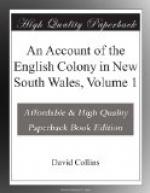We heard and saw much of the natives about this time. At the Hawkesbury a man had been wounded by some of the Wood tribe. Two women (natives) were murdered not far from the town of Sydney during the night, and another victim, a female of Pe-mul-wy’s party (the man who killed McIntyre), having been secured by the males of a tribe inimical to Pe-mul-wy, dragged her into the woods, where they fatigued themselves with exercising acts of cruelty and lust upon her.
The principal labour performed in January was preparing the ground for wheat. The Indian corn looked every where remarkably well; it was now ripening, and the settlers on the banks of the Hawkesbury supposed that at least thirty thousand bushels of that grain would be raised among them.
Several native boys, from eight to fourteen years of age, were at this time living among the settlers in the different districts. They were found capable of being made extremely useful; they went cheerfully into the fields to labour, and the elder ones with ease hoed in a few hours a greater quantity of ground than that generally assigned to a convict for a day’s work. Some of these were allowed a ration of provisions from the public stores.
In consequence of the heavy rains, the river at the Hawkesbury rose many feet higher than it had been known to rise in other rains, by which several settlers were sufferers. At Toongabbie the wheat belonging to government was considerably injured. At Parramatta the damage was extensive; the bridge over the creek, which had been very well constructed, was entirely swept away; and the boats with their moorings carried down the river. At Sydney some chimneys in the new barracks fell in.
Mr. Jones, the quarter-master sergeant of the New South Wales corps, a person of much respectability, and whose general demeanor indicated an education far beyond what is met with in the sphere of life in which he moved, died this month.
A convict lad, in the service of Mr. William Smith the store-keeper, died on the 26th, having swallowed arsenic. It was remarkable in his untimely end, that he himself placed the poison with a view of destroying the rats with which the house was infested, and was particularly cautioned against it. How he came, after that, to take it himself, was not to be accounted for.
February.] Early in February, the storehouse at the Hawkesbury being completed, the provisions which had been sent round in the schooner were landed and put under the care of Baker. Some officers who had made an excursion to that settlement, with a view of selecting eligible spots for farms, on their return spoke highly of the corn which they saw growing there, and of the picturesque appearance of many of the settlers’ farms. The settlers told them, that in general their grounds which had been in wheat had produced from thirty to thirty-six bushels an acre; that they found one bushel (or on some spots five pecks) of seed




